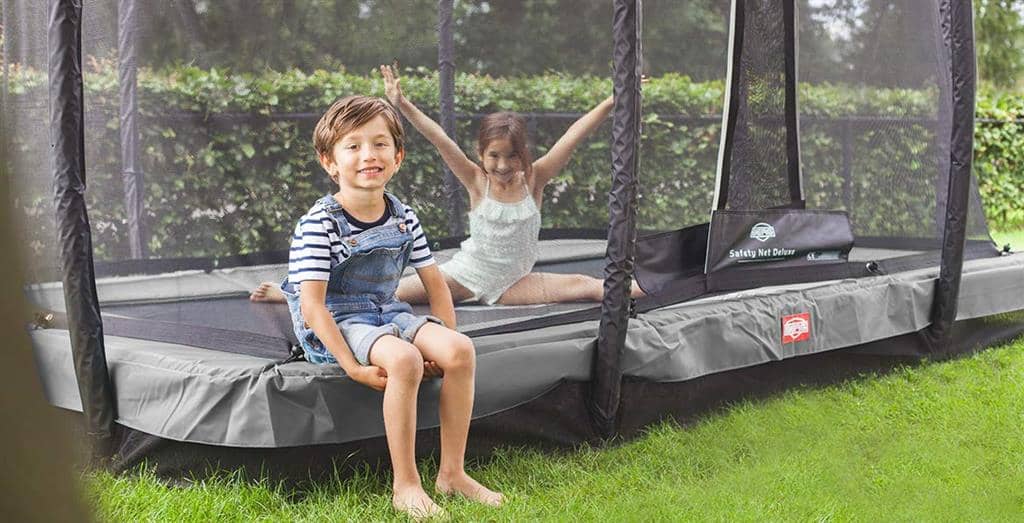How to Protect Your Inground Trampoline During a Storm
An inground trampoline is a fantastic addition to any backyard, offering fun, fitness, and a sleek, integrated design. However, like any outdoor structure, it is vulnerable to extreme weather conditions, particularly during storms.
Strong winds, heavy rain, and debris can damage the trampoline frame, jumping mat, and surrounding area. Proper preparation is essential to minimize damage and extend the life of your inground trampoline.
This guide provides step-by-step advice on how to protect your inground trampoline before, during, and after a storm, ensuring it remains safe and functional for years to come.
1. Understanding Storm Risks for Inground Trampolines
Common Weather Threats:
- High Winds – Can lift lightweight trampoline components, such as the safety net, or cause structural movement.
- Heavy Rain – Can cause water buildup in the trampoline pit, leading to drainage issues and corrosion.
- Lightning – Although rare, metal components of the trampoline could be at risk in severe electrical storms.
- Falling Debris – Branches, leaves, and other objects can damage the jumping mat or safety enclosure.
By identifying potential risks, you can take proactive measures to protect your trampoline.
2. Pre-Storm Preparation
Secure the Safety Net and Poles
If your inground trampoline has a safety net enclosure, remove it before a storm to prevent it from catching wind and acting as a sail.
- Detach the poles and lay them flat in a safe location, such as a garage or shed.
- Store the net indoors to avoid damage from wind and flying debris.
Anchor the Frame and Jumping Mat
Although inground trampolines are less susceptible to wind damage than above-ground models, strong gusts can still affect the frame.
- Use ground anchors to secure the frame, ensuring it remains stable.
- Place sandbags or heavy weights on the outer edges for additional stability.
Check Drainage Systems
Excessive rain can lead to water pooling beneath the trampoline, causing long-term damage.
- Inspect the drainage system before a storm to ensure it is clear of debris.
- If necessary, dig a small gravel pit or drainage channel around the trampoline to help redirect excess water.
Trim Surrounding Trees and Branches
Branches and debris can fall onto the trampoline during high winds, causing rips or punctures in the jumping mat.
- Cut back any overhanging branches that could break during a storm.
- Remove loose objects from the yard that may be blown into the trampoline.
3. Protecting the Trampoline During the Storm
Use a Protective Cover
A weather-resistant trampoline cover helps protect the jumping mat from heavy rain, falling debris, and wind.
- Secure the cover tightly using elastic straps or tie-downs.
- Ensure the cover is designed for inground trampolines so it does not block airflow completely, which could impact bounce performance after the storm.
Monitor Weather Conditions
If it is safe to do so, periodically check the trampoline during the storm to ensure it remains secure.
- If the wind speed increases significantly, reassess the weight distribution on the frame.
- Ensure that drainage pathways remain clear to avoid excessive water buildup.
4. Post-Storm Inspection and Maintenance
Remove Debris and Inspect for Damage
Once the storm has passed, carefully inspect the trampoline before use.
- Check the jumping mat for tears or sagging.
- Inspect the springs and frame for signs of bending or rust.
- Clear out any debris from the trampoline pit to maintain proper drainage.
Reattach the Safety Net and Poles
If you removed the safety net before the storm, ensure it is completely dry before reattaching it.
- Inspect the poles and netting for damage before reinstalling.
- Secure all attachments properly to prevent weak points that could lead to future issues.
Assess Water Drainage
If water has pooled under the trampoline, take immediate action to restore proper drainage.
- Use a sump pump to remove excess water if necessary.
- Add gravel or drainage stones to improve water flow and prevent future buildup.
5. Long-Term Storm Protection Strategies
Invest in a Wind-Resistant Trampoline Design
When purchasing an inground trampoline, choose a heavy-duty frame with durable materials that can withstand harsh weather conditions.
- Galvanized steel frames resist rust and corrosion.
- AirFlow jump mats improve drainage and reduce water retention.
Install a Permanent Wind Barrier
If your area experiences frequent storms, consider adding a fence, hedge, or windbreak to help shield the trampoline from strong gusts.
- A natural windbreak using shrubs or trees can reduce wind exposure.
- Fencing or retaining walls provide added protection without obstructing airflow.
Regular Maintenance Checks
Routine inspections and upkeep help keep your trampoline storm-ready.
- Check the frame and springs for signs of wear or loosening.
- Ensure drainage systems remain clear throughout the year.
- Replace damaged padding or covers as needed to maintain protection.
6. Summary Table: How to Protect an Inground Trampoline During a Storm
| Protection Step | Action |
|---|---|
| Pre-Storm Preparation | Remove the safety net, trim branches, check drainage |
| Securing the Frame | Use ground anchors, sandbags, or heavy weights |
| Protecting the Mat | Use a weather-resistant cover, secure it tightly |
| During the Storm | Monitor weather conditions, ensure proper drainage |
| Post-Storm Inspection | Check for damage, clear debris, reattach net |
| Long-Term Strategies | Install wind barriers, perform regular maintenance |
7. Conclusion
Taking the necessary precautions to protect your inground trampoline during a storm can help prevent costly damage and ensure safety for future use. By following these steps—preparing ahead of time, securing the trampoline properly, and conducting post-storm maintenance—you can extend the lifespan of your trampoline and minimize weather-related risks.
Whether you face frequent strong winds, heavy rains, or occasional storms, a well-maintained inground trampoline will remain a reliable and enjoyable backyard feature for years to come. Stay prepared, stay safe, and keep bouncing!
